Soloing is often described as the most pure and dangerous form of climbing. For all of us, testing the limit of what’s comfortable, whether that’s scrambling up 5.3 terrain or spending fifty days on a big wall alone, is an unparalleled mental and physical exploration.
We at Alpinist asked the most inspiring solo climbers we know–those defining the edge of what’s humanly possible–to tell us more about their rare connection to the vertical world.
After hearing from rock master Alex Honnold, big wall diva Silvia Vidal, ice climber Guy Lacelle and extreme exposure climber Alexander Huber, Steph Davis discusses the motivations and challenges that drive her to free solo and BASE jump. Read more on her blog at highinfatuation.com
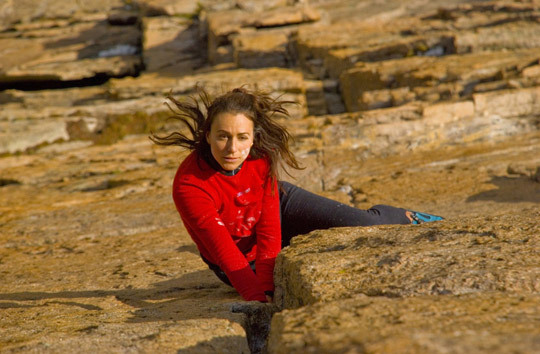
Steph Davis free soloing Pervertical Sanctuary (IV 5.10c), Long’s Peak, the Diamond, Rocky Mountain National Park, Colorado. See this image and more in Davis’s article, “Stripped,” in Alpinist 23. [Photo] Brian Kimball
1. Please tell us a bit about yourself.
I live in Moab, Utah, and have been climbing for eighteen years. I’m vegan, like BASE jumping and running a lot, and I have a dog named Fletch.
2. How did you become a professional climber?
I got a Master’s degree in literature when I was 23. After that I waited tables in Estes Park and Moab. After a couple of years, I began guiding in Moab, and started to get a few expedition grants, writing assignments and sponsorships.
3. What and when was your first free solo climb? How did it feel? What motivated you to do it?
I can’t remember! I’ve been bouldering and scrambling alone for years, and it’s always been a part of climbing for me. I really like doing things alone.
4. What drew you to free soloing before 2007? What draws you to it now?
I love heading off for an adventure alone. It gives me time to think, with no distractions. I find it easier to focus on where I am, what I’m doing and feeling.
5. 2007 was a turning point in your climbing career, for both personal and professional reasons. What shifted in your head? What drew you to free soloing over other activities?
Everyone experiences a time in life where things blow up in your face and go to pieces. That’s hard, but it does seem to lead to a stronger, more mature place in the end. For me, a lot became very clear in 2007, and some limits disappeared. I moved into more committing soloing, skydiving and BASE jumping. I see free soloing as ultimate self-reliance.
6. How many solos have you done since you started soloing in Tuolumne in 2007?
I don’t know–I solo a lot. That summer and fall, it was the only kind of climbing I was doing. Now I’m on a more normal pattern of occasional soloing, with lots of sport climbing, peak scrambling and woodying (Climbing on her home gym–Ed.). I like all kinds of climbing, and free soloing is one of the most simple, traditional styles.
7. Why so many free solos? Why the need to do some of them twice?
For me, it’s not the point to ‘survive’ a harder solo, to have done it. What is important is to feel solid and good during the climb, so it’s safe and a contemplative experience. Sometimes I repeat climbs until I reach that state, if something was off the first time. Other times I repeat because I love the route, and once the initial mental breakthrough is made, it’s better and more enjoyable the next time, since I truly know I can do it and don’t have to wonder. It can be like that for me with BASE jumping too–more fun the second time at a new site. Even when I am 100 percent sure I can solo a route safely, there’s still that big question mark the first time: how is it going to feel without the crutch of the rope? I never really know how the cruxes are going to feel, in full commitment, even if I’ve led them with only one piece of gear. That’s why although I think the preparation for a hard solo is the most valuable part of the discovery process, the actual act of doing it is necessary too.
8. Can you define in one word what need you are trying to satisfy when free soloing?
Maybe two words: clarity and control. Soloing is the best way I have to be truly clear with myself, and to practice self-control. Self-examination is really fulfilling, and seems to grow richer over time.
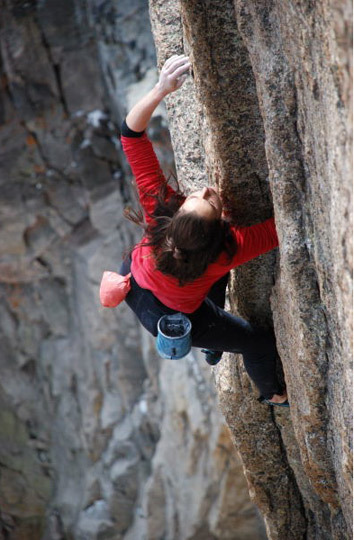
Steph Davis free soloing Pervertical Sanctuary (IV 5.10c). [Photo] Brian Kimball
9. What does free soloing bring to your daily life?
I find easy soloing to be a relaxing and pure way to visit the moderate climbs I most love. When doing solos that are harder, it is a way to experiment with mental awareness and mind control.
10. What from your daily life do you bring to free soloing?
A clean mind and a pure focus are the keys to safety and confidence for me.
11. In your article “Stripped” in Issue 23, you write, “Death became an abstract, not a pressing, concern.” Would you please elaborate?
This is a pretty personal subject, but something a lot of people might relate to. I was in a dark place at that time, which was not something I’d dealt with before. I was having a hard time, and at first I found that soloing brought me relief. When I was soloing, I didn’t think about death. I felt alive and realized I wanted to feel alive, in those moments. So it started as kind of a band-aid, but it was ultimately very healing and took me to a very good place.
12. You also write: “Soloing was not just an expression of freedom and a way to flirt with death; it was a rebellion against fear.” It sounds like fear was keeping you imprisoned. Can you explain how fear was affecting your life and why you chose scary activities (free soloing and BASE jumping) to fight it? What place does fear hold in your life now, and how does soloing combat it?
It took me some time to identify fear as the thing that limits freedom and happiness. Doing physical acts that I find scary, and figuring out how to feel in control, is part of an exploration into fear and understanding how to be free from it. Unattachment is part of this too. I don’t want to be controlled by fear.
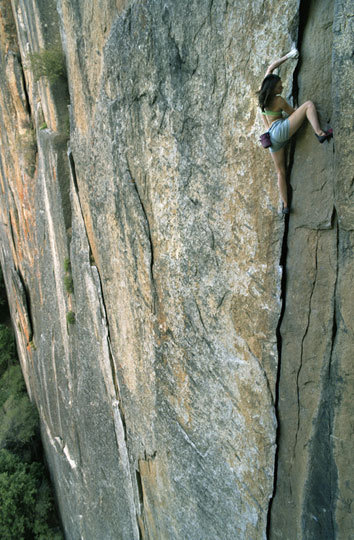
Steph Davis free soloing Outer Limits (5.10c), Yosemite National Park, California. [Photo] Dean Fidelman
13. In the article, you talk about “loose relaxation.” How do you stop fear from controlling you and doubts from affecting your climbing?
I don’t go for any solo unless I truly believe, 100 percent or more, that I can climb it without falling. So then there’s no reason to be afraid during the climb. Taking the gradual, conservative steps to reach that point of certainty is a very interesting and worthwhile process, one I really like. Throughout the actual moments of a committing route, I focus on deep breathing. I consciously refuse to allow doubt or negativity to enter my mind. Everything is about positive thoughts and good feelings. These experiences are really powerful, and they carry over into the other moments of my life. Immersing myself in high-risk activities gives me perspective, and makes me feel pretty relaxed about most things in life.
14. You speak of surrendering: can you explain what you surrender to in soloing?
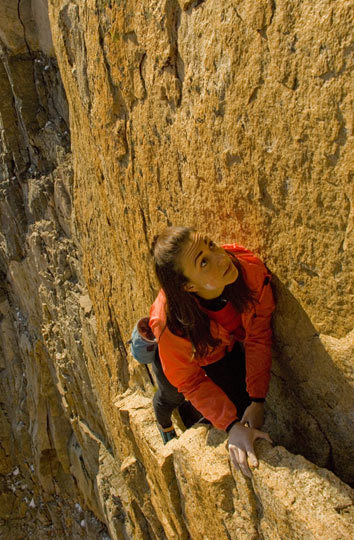
Steph Davis negotiating the top of the fourth pitch as she traverses into the start of Pervertical’s splitter crack systems–5.10 climbing above 13,000 feet. See this image and more in Davis’s article, “Stripped,” in Alpinist 23. [Photo] Brian Kimball
Soloing is a lot about control. But I got to another level when I found out how to let go of things, on a bigger plane, which I learned from skydiving. Surrender is very liberating. Letting go of attachments, fear, anxieties– these things can be foreign to a climber, who feels conditioned to hold on. Letting go, for me, was the key to the next level.
15. To free solo, you need a lot of self-confidence. Yet, for you, soloing helped you regain your lost self-confidence. Can you explain why and how this worked for you?
It felt right, when I was having a hard time finding direction, and it led me back to a place I find natural and peaceful.
16. Would you call free soloing an addiction?
For me, it is a form of self-expression, and an integral part of climbing, just like all the other styles of climbing we practice.
17. How do you mentally prepare for a free solo?
I spend a lot of time thinking about possible outcomes. I think honestly about the thought of falling, and what that means to me. I get these thoughts done before I go to the climb, so I don’t need to do this thinking during the climb. “Be relaxed, have good feelings,” is something I repeat to myself sometimes throughout a long solo. I imagine myself moving up perfectly through the entire climb, and never visualize falling at all or even allow myself to think about it. I find that whatever I think or say is often what happens in life.
18. In BASE jumping, you are falling. In free soloing, falling is not an option. For you, how do the two complement each other?
Both are about precision, mastery and faith. I’m amazed by the similarities between climbing and BASE. They seem to be opposite because of the direction of motion, but in fact, they are both expressions of the relationship between the human body, gravity and the mountains. They differ in that climbing can be slower, and can slide into being goal oriented due to the quantitative nature of our modern approach to it. BASE jumping has taught me to value every single second, and that being alive and happy is success.
19. Dan Osman said: “You don’t wanna die, right? So, you just don’t fall!” It sounds like Osman felt immortal, yet you feel very mortal. Can you explain this difference in perspective?
I feel very aware that I am going to die, because we all–all living creatures–are going to die. It’s the one thing we know for sure in this life. I realized long ago that avoiding seemingly risky activities is not going to prevent death. Since I do a lot of committing things, I think realistically about consequences, but I will not be kept a prisoner by the fear of them. I think that is the ultimate trap.
20. Does free soloing define who you are?
No, but the approach I take is very characteristic of who I am.
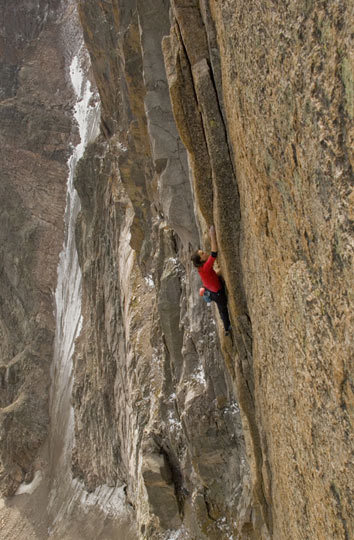
Steph Davis entering Pervertical’s ca. 500 feet of classic splitter cracks. See this image and more in Davis’s article, “Stripped,” in Alpinist 23. [Photo] Brian Kimball
21. What was your scariest moment on a solo climb? How did you deal with it?
The most afraid I’ve been was during a solo of Snake Dike on Half Dome on my 23rd or 24th birthday. I didn’t know anything about the route, and I got lost on the approach and summitted Half Dome by the cables route, and then found the turnoff to Snake Dike as I was hiking back down. So it took me a lot of miles to get to the base, and it was late in the day when I started climbing. It took me completely by surprise that the crux was a friction slab move, because I didn’t like to solo things that were slabby, I just knew it was supposed to be an easy route. So I was really afraid doing that friction move, trusting my shoe rubber, with tired legs–When I set out in the morning, I didn’t think much in advance about what I was getting into, about consequences, or outcomes, I just wanted to do the climb, and generally knew where it was and the grade. It taught me to make sure I find out what I’m getting into, at least by getting some information about the approach, the route, and the descent, and to think carefully before running off to solo something, even if it has an easy grade. I have learned a lot since then, but that experience was very special for me.
22. What is your advice for young alpinists who look up to your accomplishments?
Listen a lot and trust yourself.